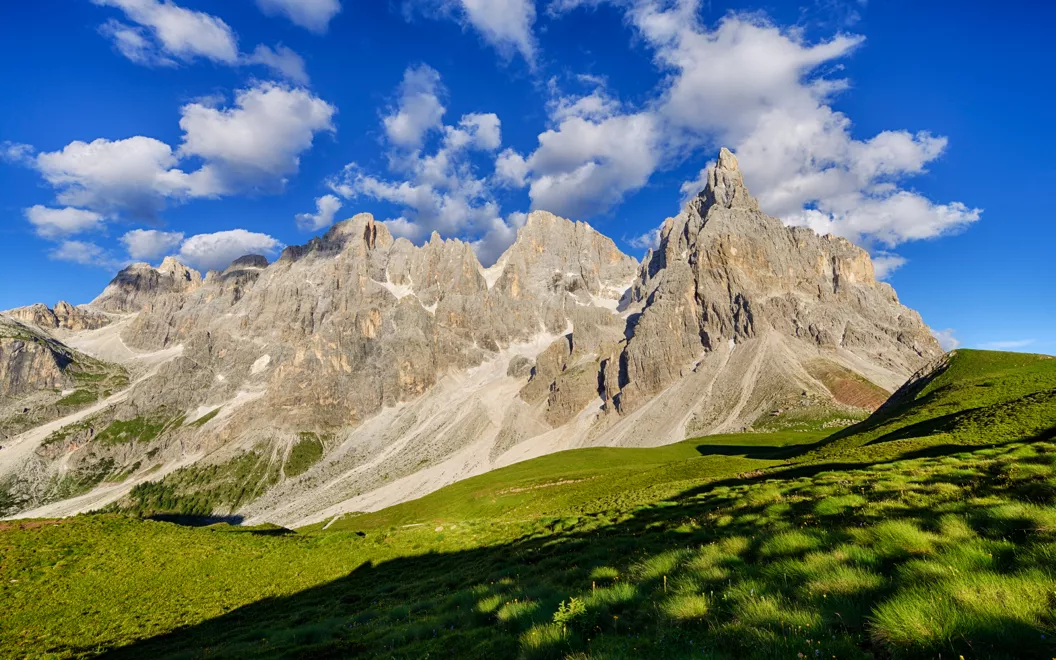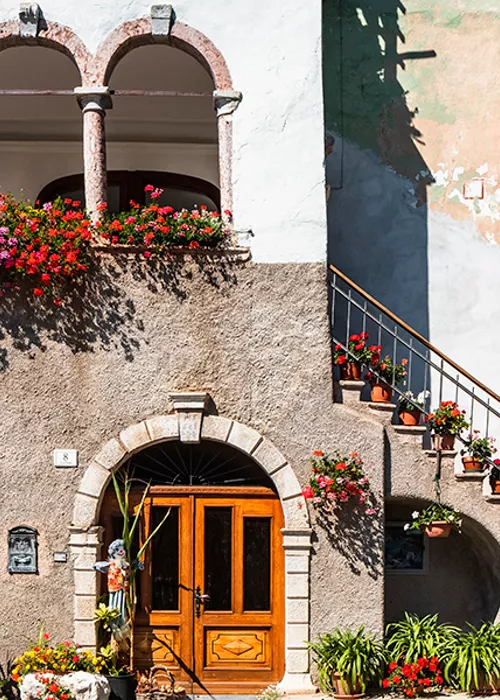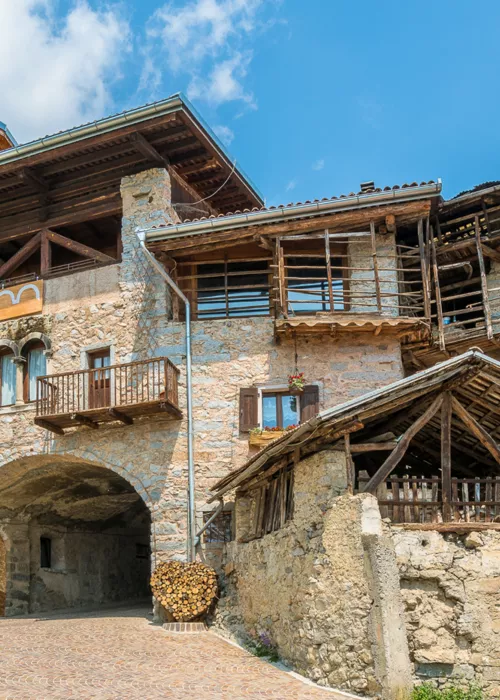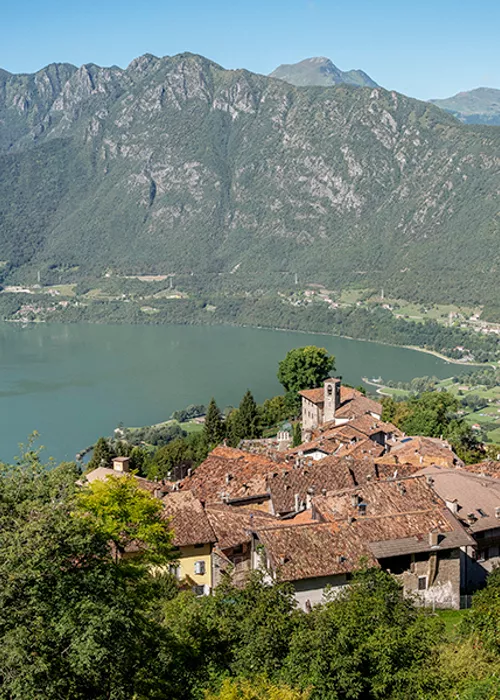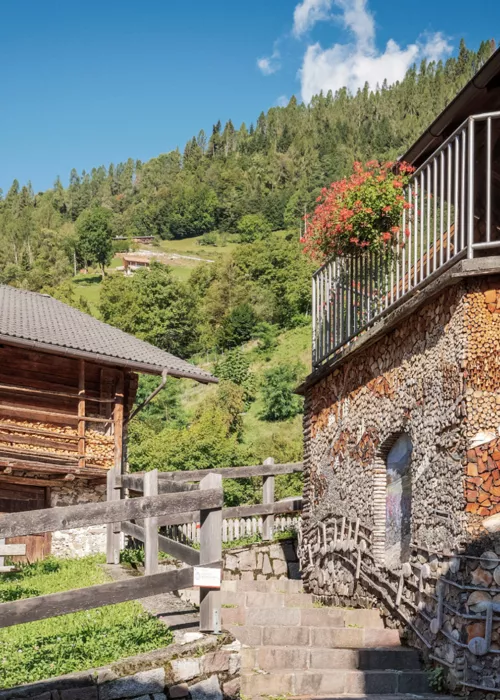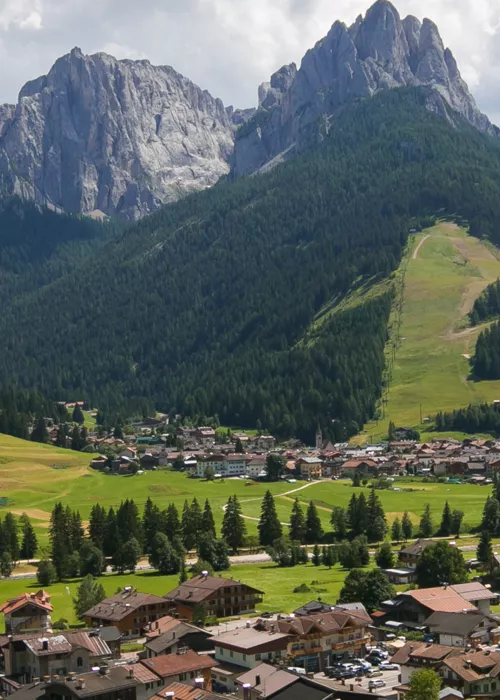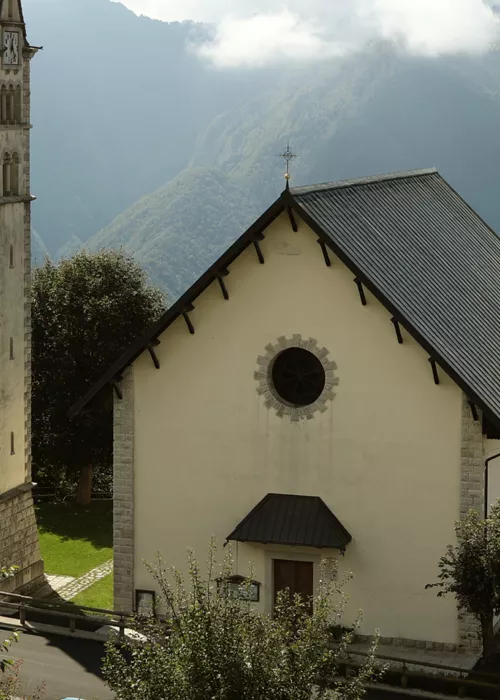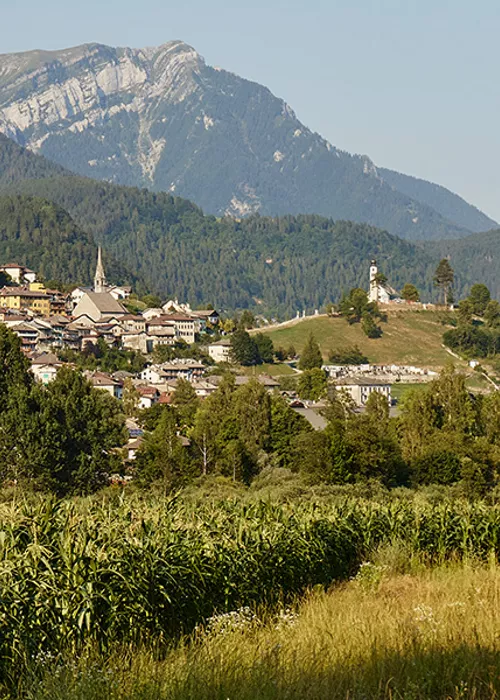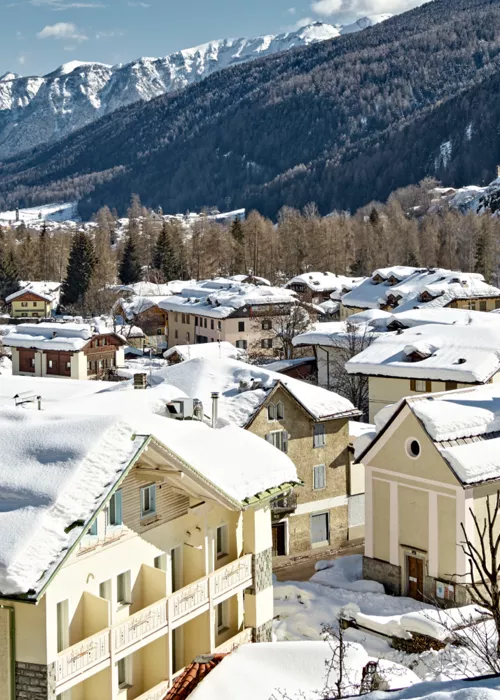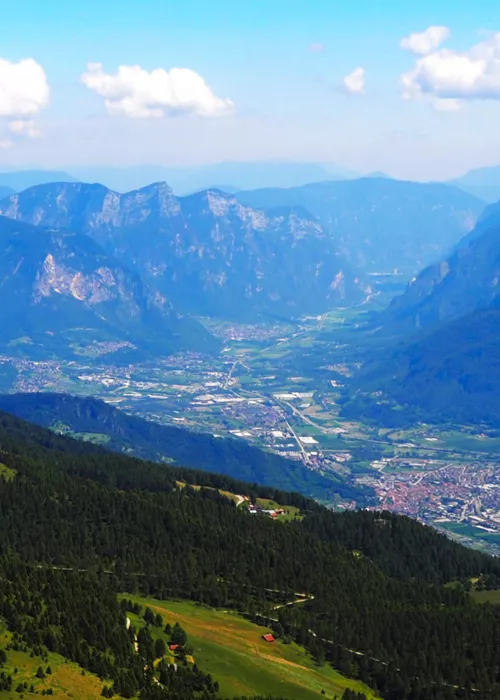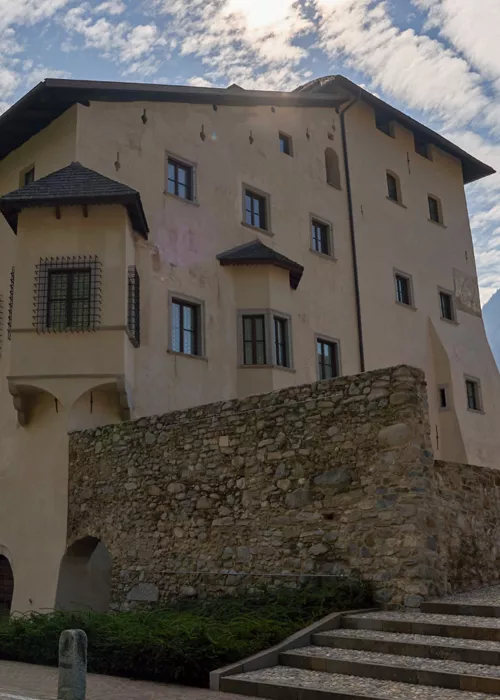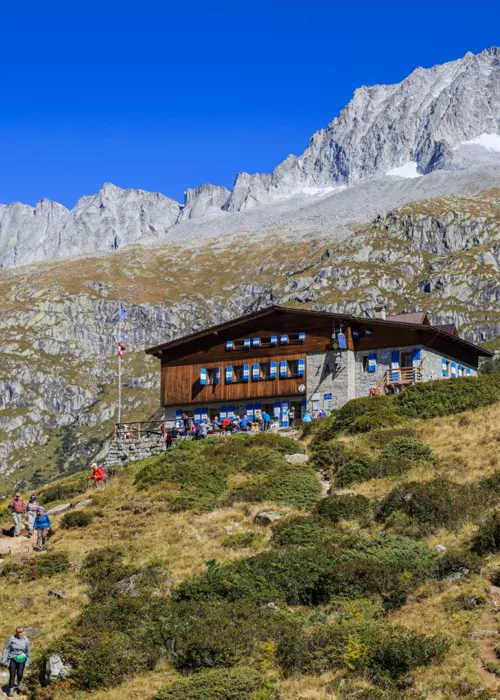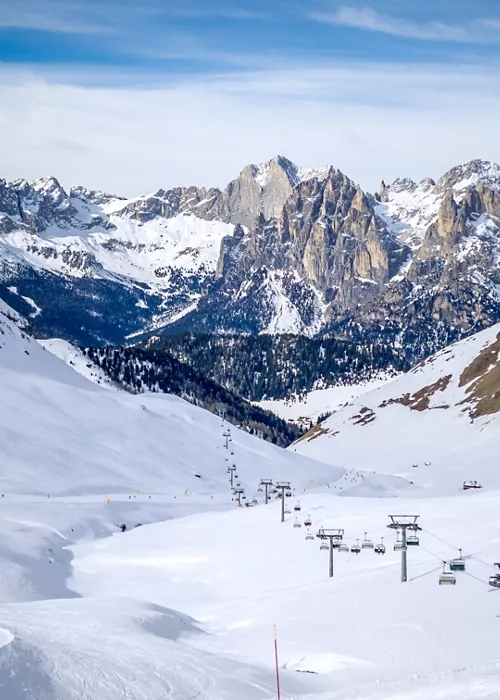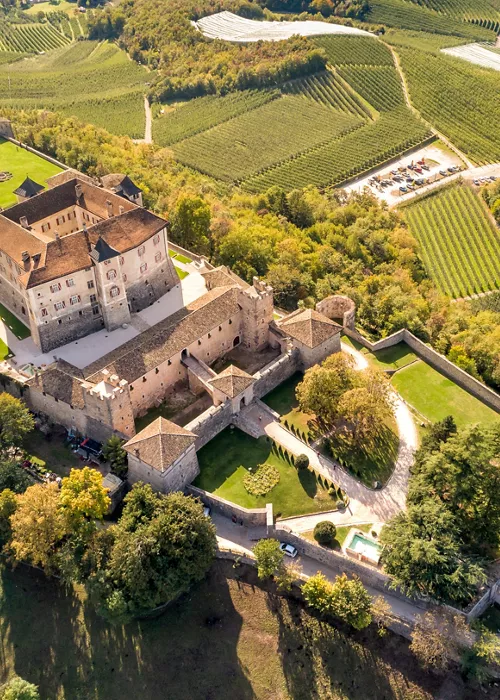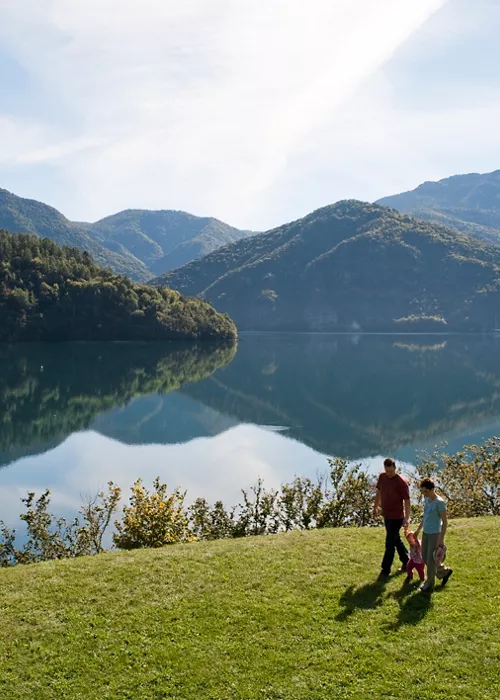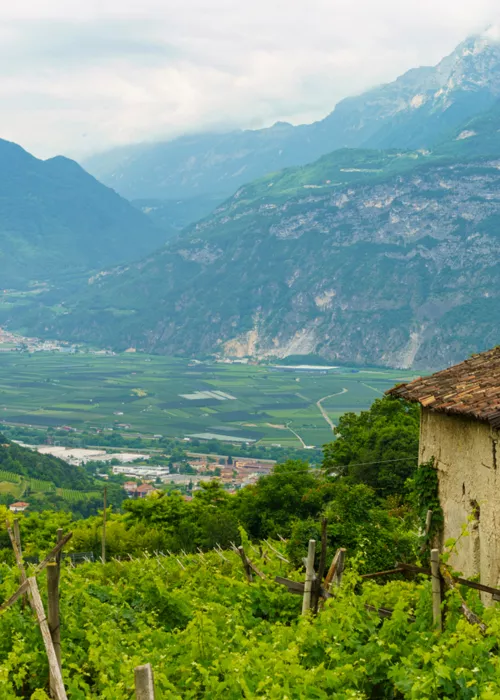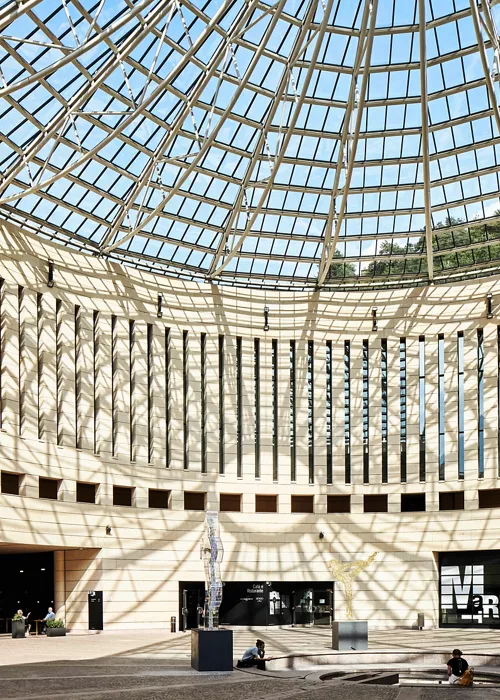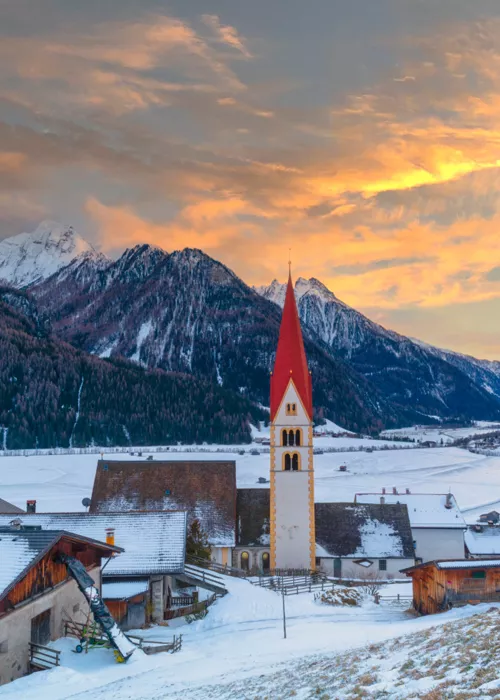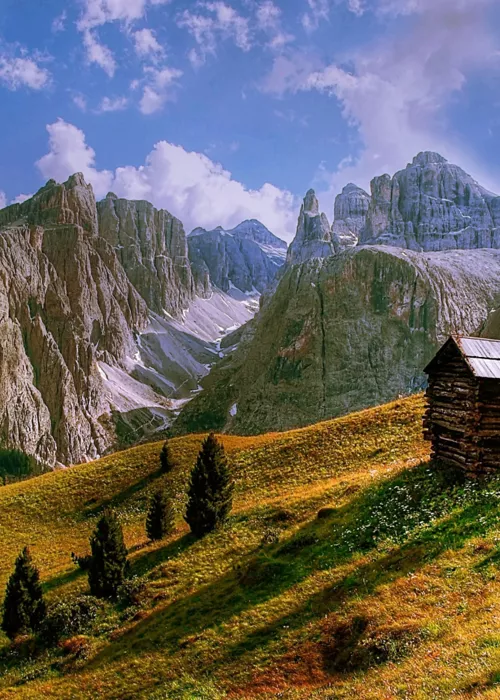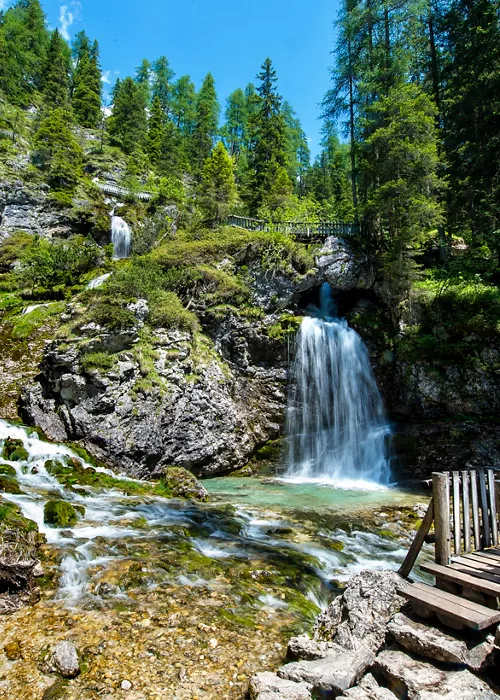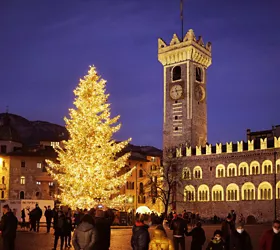Discover the beautiful villages of Trentino
10 minutes
Trentino boasts no fewer than 11 locations recognised as \"the most beautiful villages in Italy\". They are special places, where you can really savour the taste of tradition. Nestling in secluded locations amid forests or mountain pastures, for centuries the source of sustenance to local communities, the villages of Trentino welcome you with cobbled courtyards, fountains, mural paintings of saints and angels on the stone walls, porticoes, barns and balconies made of timber, still used today to dry corn cobs and nuts.
San Lorenzo
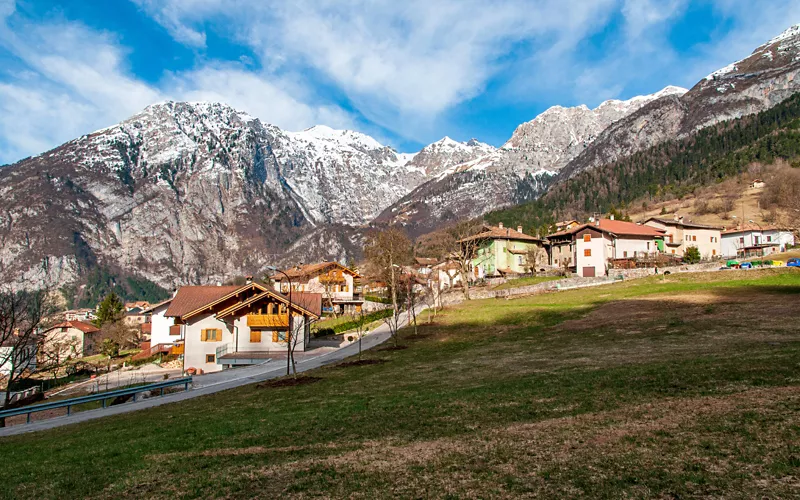
San Lorenzo, the wellbeing village. Located at the foot of the Brenta Dolomites, this village was born from the fusion of seven \'villas\': Berghi, Pergnano, Senaso, Dolaso, Prato, Prusa and Glolo. As you amble through the little streets of the seven hamlets, you can still see some rare and unusual rustic architecture, like the \"pont\", ramps built to allow carts access to the drying rooms, barns and haylofts on the top floors of the houses. The presence of yoga studios and wellness practitioners only enhances the relaxing atmosphere. San Lorenzo is also the home of the \"ciuiga\", a type of cured sausage recognised by Slow Food, which has its own weekend festival in mid-autumn. To sample this local delicacy, visit the Ristoro Dolomiti di Brenta, at the entrance to the Ambièz Valley, perhaps after a mountain hike.
Rango
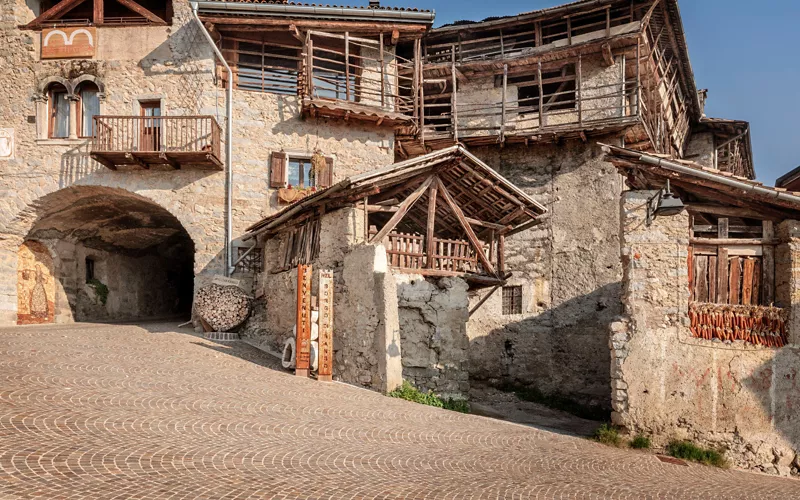
Rango, a rustic heart. As you travel up towards the Bleggio plateau with its ancient parishes, through the rural landscape dotted with fields of mountain potato, you come to Rango. The \"portech de la Flor\" is the first typical residential building that catches the eye. This monumental building is the oldest part of the village, and set the standard for all the other \"porteghi\" which have been constructed since. In this little village you can see porticoes, orches, courtyards, grand fountains and walls made of stone, cobbled streets and ancient houses. It is a true compendium of rural architecture, and seems to be suspended in the time when it was inhabited by shepherds and their flocks, pilgrims, merchants and travellers. Just a few minutes\' walk separates the village of Rango from Balbido, known as the \"painted village\" because of the colourful murals on the houses. The Bleggio walnut, now a Slow Food delicacy, forms the basis of many tasty local dishes. There is also a walnut trail, a gentle walk through country roads, meadows and crop fields.
Canale di Tenno
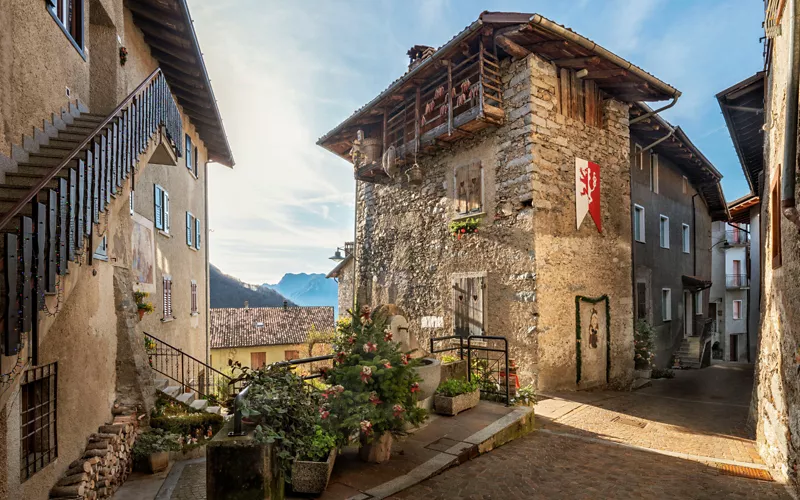
Canale di Tenno, the medieval village. As you stroll along the cobbled streets with the overhanging stone dwellings you pass below archways, porticoes and strong stone walls that connect the houses to each other. One of the internationally-famous landmarks of the village is the Casa degli Artisti \"Giacomo Vittone\", a venue that hosts exhibitions and art events from March to December each year. The real speciality of this area is the \"carne salada\", a savoury meat dish that pairs perfectly with the locally-grown \"fasoi\" (beans).
Bondone
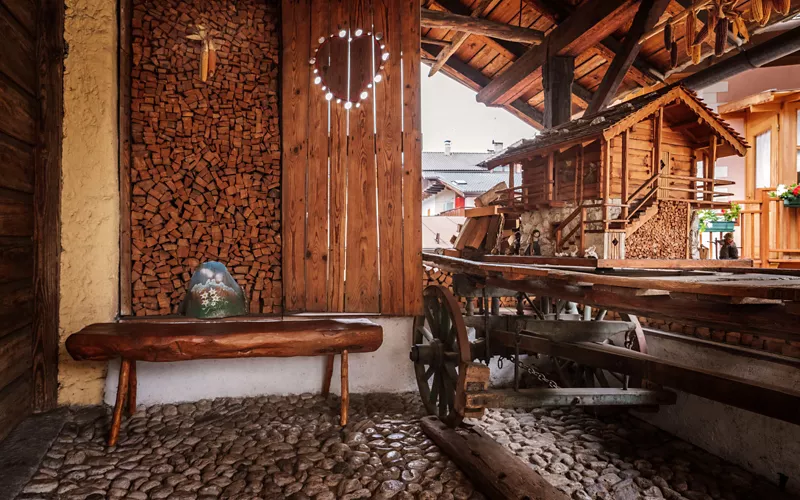
Bondone, the village above the clouds. We are now in the southernmost municipality in the Chiese valley, facing the northern shore of Lake Idro on the border with Lombardy, where this village was originally founded as the home of charcoal burners. Taking a walk through the village, as you wander through narrow streets, duck under arches and squeeze your way up the steep flights of steps between the houses, touching the mossy dry-stone walls and admiring the murals such as the 16th-century \"Virgin Enthroned\", is like stepping back to a harsh and distant time. A time when the charcoal burners and their families would live here for only four months, leaving the village desolate and silent for the rest of the year. Don\'t miss a visit to the nearby Castel San Giovanni, built right on top of the rock. Here you can sample the local polenta, made with the famous yellow flour of Storo, a symbol of the Chiese Valley.
Mezzano
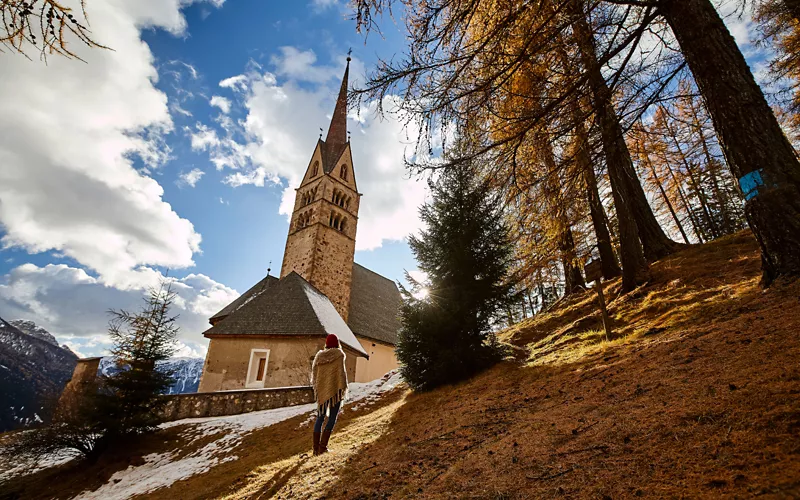
Mezzano, for a romantic getaway. In the Primiero valley, with its artistic wooden buildings and views of the Dolomites, the village of Mezzano is a haven of alpine life and an inexhaustible mine of inspiration. Tucked away around every corner there is something new to see along the narrow streets or \"canisels\", in the squares and below the balconies of this vibrant open-air museum. The best way to experience Mezzano is simply to walk some of the themed trails that invite you to spot the local landmarks, notably the famous stacks of timber transformed into art, thanks to the Cataste&Canzei project. At the Primiero dairy, you can buy the famous \"tosèla\", the traditional local soft cheese, and in summer also the \"Botìro\" pasture butter.
Vigo di Fassa

Vigo di Fassa, below the castle of King Laurino. In the Trentino Dolomites there is another \"most beautiful village in Italy\". It is the cradle of Ladin culture, which lies at the foot of the Catinaccio - Rosengarten massif, a World Heritage Site that legend says was once the home of Laurino, king of the dwarves. At the entrance to the town of Vigo you will find the Ladin Museum, which safeguards the wealth of Ladin tradition and cultural heritage. Vigo has many hamlets, including Tamiòn, a small community 4 km from the village. Among the houses and old haylofts there is also a small church, dedicated to the Holy Trinity. The Gothic church of St Juliana is one of the oldest in the valley. Dedicated to the patron saint of the Fassa Valley, it contains valuable 15th-century frescoes. The church stands on the Doss del Ciaslìr, a prehistoric sacred site, which has been linked to the witchcraft trials that scandalised the people of the Fassa valley in 1627-28. Here we are also on the Dolomite Cheese Trail, which in the Fassa Valley is represented by the "Cher de Fascia" and the "Puzzone" of Moena.
Luserna
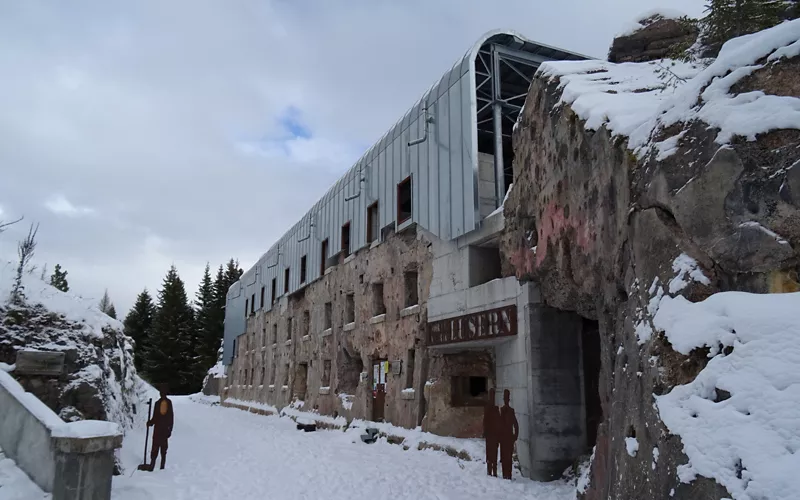
Luserna, memories of the Cimbri. This mountain hamlet is a handful of houses that at first light of dawn appear to be suspended in the fog over the Astico Valley, as it rises to the edge of the rocky outcrop caught in a swirl of mist overlooking the west of the village. Luserna/Lusérn, a mountain village at 1,333 m south-east of Trento, is truly an island, the last where the Cimbrian language, an ancient Bavarian idiom, is still spoken fluently by 90% of the population. In the foothills between the Adige and Brenta rivers, around 1,500 Cimbri today declare themselves to be Cimbri, and among them, the majority of the 250 current inhabitants of Luserna. Secluded and immersed in this fascinating natural setting, it is located on the central-southern border of a large alpine pastureland that stretches between Folgaria, Lavarone and Passo Vezzena overlooking the Valle dell\'Astico. The Lusérn Documentation Centre/Dokumentationszentrum Lusérn, housed in the old 19th-century German school, is responsible for the preservation and enhancement of Cimbrian culture. It is a museum with sections dedicated to history and traditions, local fauna, the Bronze Age smelting furnaces and the Great War (it was in the square and church of Luserna that the first Italian bombs fell at dawn on 25 May 1915 in the territories of the Austrian-Hungarian Empire). The Haus von Prükk House Museum is the emblem of the traditions of this minority: it is the result of the conservative restoration of an old farmhouse that had retained its characteristics of a 19th-century farmhouse.
Pieve Tesino
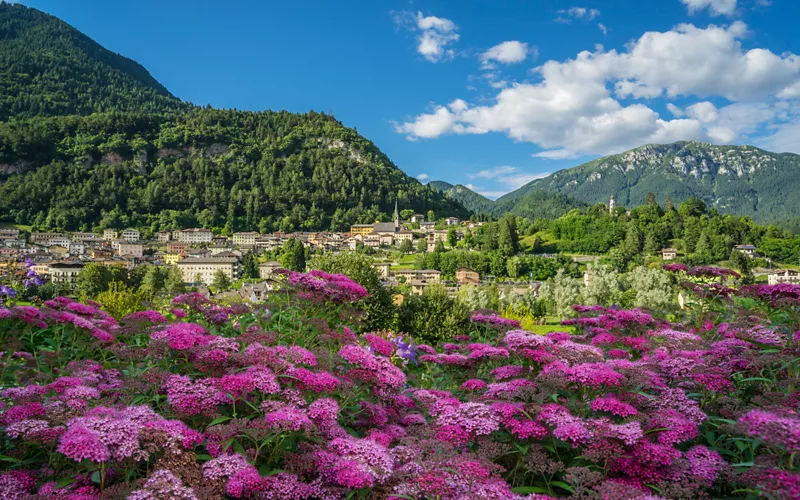
Pieve Tesino, the village of peddlers. The village of Pieve Tesino is known for being the birthplace of statesman Alcide De Gasperi (1881–1954), to whom the Casa Degasperi Museum is dedicated. Pieve, so called because it has been the seat of the valley\'s Pievana Church since time immemorial, fans out at the foot of the Bosco di Santa Maria, and is laid out on short terraces connected by crossroads, paved in part by the \'cobblestones\' collected in the bed of the nearby Grigno stream (a tributary of the Brenta), and, in the upper part, by bold granite staircases. The heart of the village is the Piazza Maggiore, where the \"lady of the fountains\", an ancient octagonal fountain in red stone, stands out. At the Museum per via, inside Casa Buffa Giacantoni, there is a collection of testimonies to the epic of the wandering peddlers who set off from this area to travel unthinkable routes on foot across the continents. A typical Tesino product is \'le Verde\', sauerkraut prepared by shredding cabbage and subjecting it to lactic fermentation to be eaten cold and seasoned.
Ossana
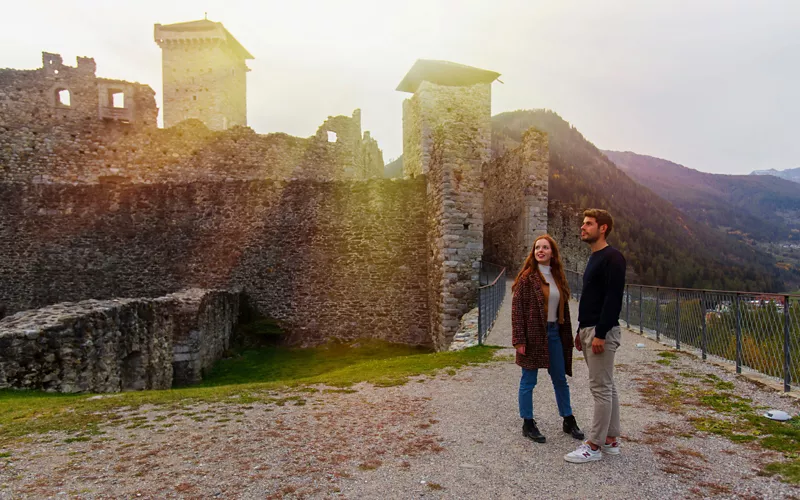
Ossana, in the shadow of the disputed castle. In the upper Val di Sole, Ossana is located at the entrance to the Val di Peio, at the foot of the peaks of the Presanella group and is the seat of the municipality to which the hamlets of Fucine and Cusiano belong. The village is dominated by the tower of the Castello di San Michele, one of the most iconic places in Val di Sole, whose history is largely linked to that of the castle, often disputed between the bishop of Trento and the Count of Tyrol and inhabited by various feudal families. It stands on a hill that recent excavations have confirmed has been inhabited since the Bronze Age. The castle, surrounded by two lines of walls and 16th century ramparts, has its most characteristic element in its mighty donjon. At 25 metres high, it dominates the valley and remains the best-preserved architectural element of the entire complex. Still in the heart of the village, in an 18th-century mansion, now the headquarters of the San Vigilio Foundation, one can admire the \"Stuva Nova\", a room furnished with richly ornamented carved wooden walls, a precious stove, paintings and much of the original 18th-century furniture. At the entrance to the village, in the Parco della Pace on the Tomino Hill, stands the Austro-Hungarian Monumental Cemetery where the Monument to the Austrian Kaiserschütze, the work of the sculptor Othmar Schrott-Vorst, was created in 1917. Speaking of local products, mention must be made of \"Casolèt\" cheese, a typical soft mountain cheese, made from raw milk, to be eaten fresh; it has a sweet and delicate flavour and is suitable for all palates.
Borgo Valsugana
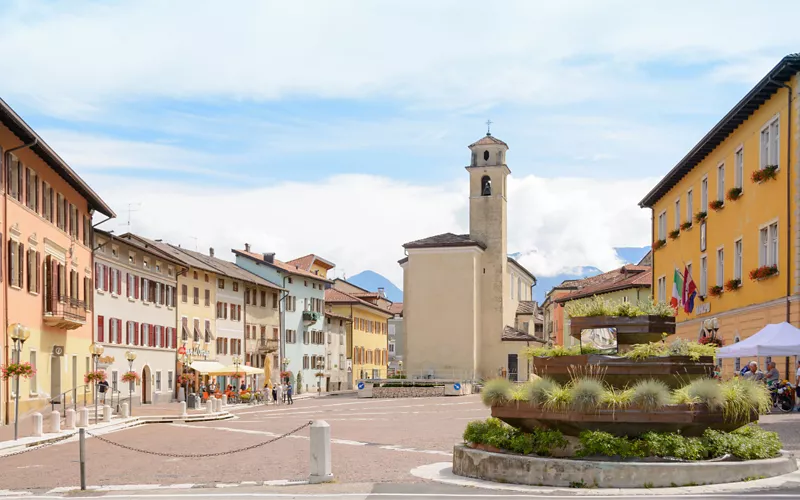
Borgo Valsugana, riverside scenes and memories of Veneto. As the main town in the Lower Sugana Valley, it has the most attractive urban riverside setting still remaining in Trentino. Borgo Valsugana has an almost perfectly preserved medieval structure with a maze of irregularly-shaped streets, mews and courtyards, while along the old imperial road there are rows of austere Renaissance and Baroque palaces. The town has lots to see, including the Lungobrenta arcades, the Venetian bridge, the ancient Corso Ausugum with its late-Renaissance and Baroque buildings, a number of churches and piazzas. Borgo Valsugana is an ideal destination for an eco-sustainable holiday. Located on the Trento-Bassano railway line, the town is crossed by the Valsugana cycle trail which connects Pergine and Lake Caldonazzo to Bassano del Grappa. The trail is 80 km long, and takes in some of the culture, history and landscapes on the border between Trentino and Veneto. In the village you will also find a new artistic project by Arte Sella, called the Sky Museum: it consists of three installations created in collaboration with the local council. Another treasure waiting to be discovered is Castel Telvana, which stands proudly over the town from the top of Mount Ciolino.
Caldes
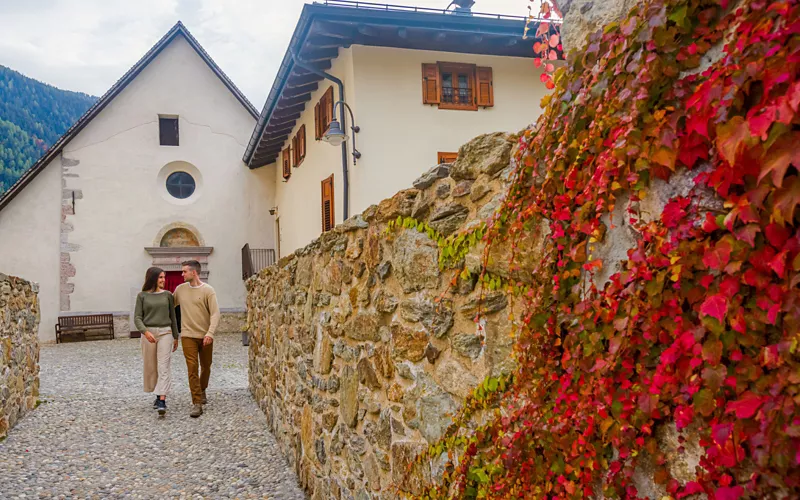
In August 2023, Caldes was officially recognised as one of Italy\'s most beautiful villages. Along with Ossana, it is the second in the Sole valley to receive the accolade thanks to its clearly-defined identity and cultural heritage efforts. The key element of Caldes is its majestic castle: initially it was only a five-storey tower, erected around 1230-1235, at the behest of Rambaldo and Arnoldo da Cagnò. In 1464 the tower passed to the Thun family, who enlarged it, giving the building its present appearance. Next to the castle is a chapel dedicated to the Virgin Mary. Other points of interest in the village are the Church of St Roch, with a stone pyramidal-cusp bell tower and a beautiful wooden altar attributed to Simone Lenner, and also Palazzo Manfroni, whose owners have done much to preserve its historic value. On the banks of the Noce is the Contre Sports Centre, equipped for river pursuits and other sports. It is also a river rescue training centre.
The buildings and houses, including Casa Fattarsi, Casa Lorengo and Palazzo Manfroni, have an impressive street frontage with interesting stone portals and mullioned windows, with an \'agricultural\' section with kitchen garden and hayloft behind them. You can also learn more about the local history by scanning the various QR codes located at points around the town.

